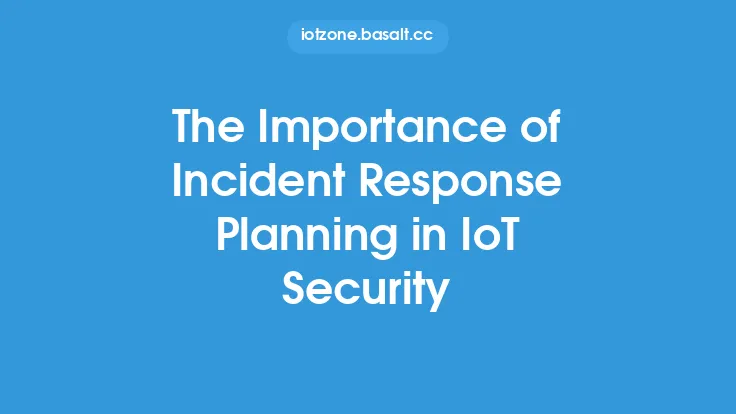The increasing complexity and interconnectedness of Internet of Things (IoT) devices have created new challenges for incident response. As the number of IoT devices grows, so does the potential for security breaches and incidents. Automation plays a crucial role in IoT incident response, enabling organizations to quickly respond to and contain security incidents. In this article, we will explore the role of automation in IoT incident response, its benefits, and the technologies used to automate incident response processes.
Introduction to Automation in IoT Incident Response
Automation in IoT incident response refers to the use of software and systems to automatically detect, respond to, and contain security incidents. Automation enables organizations to respond quickly and effectively to security incidents, reducing the risk of data breaches and minimizing downtime. Automation can be applied to various stages of incident response, including detection, containment, eradication, recovery, and post-incident activities. By automating these processes, organizations can improve the efficiency and effectiveness of their incident response efforts.
Benefits of Automation in IoT Incident Response
The benefits of automation in IoT incident response are numerous. Automation enables organizations to respond quickly to security incidents, reducing the risk of data breaches and minimizing downtime. Automated systems can detect and respond to security incidents in real-time, reducing the time it takes to contain and eradicate threats. Automation also enables organizations to respond to security incidents consistently, reducing the risk of human error. Additionally, automation can help organizations to scale their incident response efforts, enabling them to respond to a large number of security incidents simultaneously.
Technologies Used in Automation of IoT Incident Response
Several technologies are used to automate IoT incident response processes. These include security information and event management (SIEM) systems, incident response platforms, and security orchestration, automation, and response (SOAR) solutions. SIEM systems provide real-time monitoring and analysis of security-related data, enabling organizations to detect and respond to security incidents quickly. Incident response platforms provide a centralized platform for managing incident response efforts, enabling organizations to automate and streamline their incident response processes. SOAR solutions provide a framework for automating incident response processes, enabling organizations to define and execute incident response playbooks.
Automation of Incident Detection
Automation plays a critical role in incident detection, enabling organizations to detect security incidents in real-time. Automated systems can analyze security-related data from various sources, including network logs, system logs, and security event logs. These systems can use machine learning and analytics to identify patterns and anomalies in security-related data, enabling them to detect security incidents quickly. Automated systems can also use threat intelligence feeds to stay up-to-date with the latest threats and vulnerabilities, enabling them to detect security incidents more effectively.
Automation of Incident Containment
Automation is also critical in incident containment, enabling organizations to quickly contain security incidents and prevent them from spreading. Automated systems can use network access control (NAC) systems to isolate affected devices and prevent them from communicating with other devices on the network. These systems can also use firewall rules and intrusion prevention systems (IPS) to block malicious traffic and prevent attackers from gaining access to sensitive data. Automated systems can also use encryption to protect sensitive data, preventing attackers from accessing or exploiting it.
Automation of Incident Eradication
Automation plays a crucial role in incident eradication, enabling organizations to quickly eradicate security incidents and restore systems to a known good state. Automated systems can use patch management systems to apply patches and updates to affected systems, eliminating vulnerabilities and preventing attackers from exploiting them. These systems can also use configuration management systems to restore systems to a known good state, eliminating any malicious configurations or settings. Automated systems can also use malware removal tools to remove malware and other malicious software from affected systems.
Automation of Incident Recovery
Automation is also critical in incident recovery, enabling organizations to quickly recover from security incidents and restore systems to normal operation. Automated systems can use backup and restore systems to restore data and systems from backups, enabling organizations to quickly recover from security incidents. These systems can also use disaster recovery systems to restore systems and data from disaster recovery sites, enabling organizations to quickly recover from security incidents. Automated systems can also use continuous integration and continuous deployment (CI/CD) pipelines to quickly deploy new versions of software and systems, enabling organizations to quickly recover from security incidents.
Challenges and Limitations of Automation in IoT Incident Response
While automation plays a critical role in IoT incident response, there are several challenges and limitations to its adoption. One of the main challenges is the complexity of IoT systems, which can make it difficult to automate incident response processes. IoT systems often consist of multiple devices and systems, each with its own unique characteristics and requirements. This can make it challenging to develop automated systems that can detect and respond to security incidents effectively. Another challenge is the lack of standardization in IoT systems, which can make it difficult to develop automated systems that can integrate with multiple devices and systems.
Best Practices for Implementing Automation in IoT Incident Response
To implement automation in IoT incident response effectively, organizations should follow several best practices. First, organizations should develop a comprehensive incident response plan that outlines the roles and responsibilities of automated systems. This plan should include procedures for detecting, containing, eradicating, recovering from, and post-incident activities. Organizations should also implement a SIEM system to provide real-time monitoring and analysis of security-related data. Additionally, organizations should implement an incident response platform to provide a centralized platform for managing incident response efforts. Finally, organizations should continuously monitor and update their automated systems to ensure they remain effective and efficient.
Conclusion
In conclusion, automation plays a critical role in IoT incident response, enabling organizations to quickly respond to and contain security incidents. Automation can be applied to various stages of incident response, including detection, containment, eradication, recovery, and post-incident activities. By automating these processes, organizations can improve the efficiency and effectiveness of their incident response efforts. While there are several challenges and limitations to the adoption of automation in IoT incident response, organizations can overcome these challenges by following best practices and continuously monitoring and updating their automated systems. As the number of IoT devices continues to grow, automation will play an increasingly important role in incident response, enabling organizations to respond quickly and effectively to security incidents.





